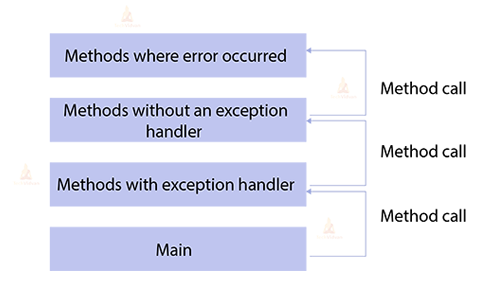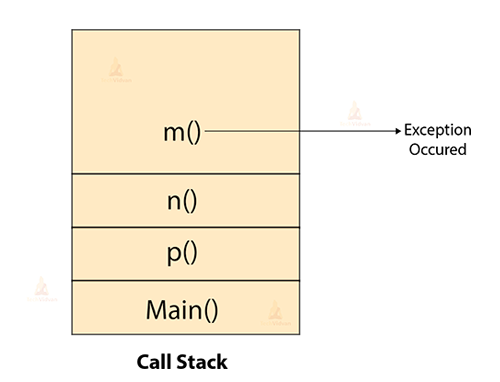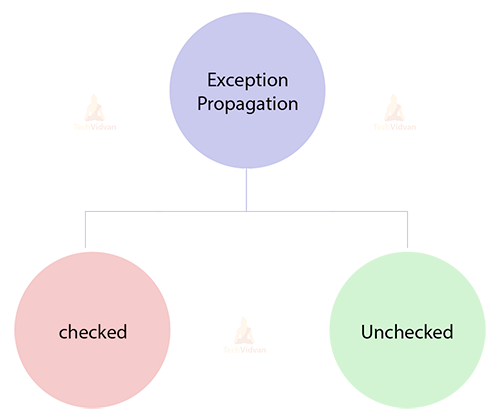Exception Propagation in Java
Exception propagation is more than just a technical concept; it reflects the intricate interplay between code design, fault tolerance, and user experience. In the face of diverse scenarios – ranging from minor glitches to critical system failures – understanding how exceptions traverse through different layers of a software system is paramount.
This journey of error propagation offers valuable insights into the inner workings of a program, revealing the routes taken by exceptions as they traverse across methods and classes.
Java Exception Propagation:
Exception propagation, also known as exception forwarding, refers to the process in which an exception that occurs in a method is passed on to the calling methods or higher levels of the program’s execution stack.
This mechanism allows exceptions to be handled at appropriate levels of the code, enabling proper error handling and recovery.
An exception initiates its journey from the uppermost point of the call stack. Should it remain uncaught at this initial location, it descends through the layers of the call stack, retracing its path to the method that was invoked prior. Once an exception is hurled by a method, the runtime system undertakes a quest to locate a suitable entity capable of addressing the issue. This search involves scouring the sequence of methods that were successively invoked, ultimately leading to the origin of the error. This chronological sequence of methods forms the call stack, while the process of systematically probing these methods for an exception handler is akin to traversing a labyrinthine trail.
In Java, exceptions are automatically propagated up the call stack until they are caught and handled by an appropriate catch block.
Here’s how exception propagation works:
Exception Occurs: When an exceptional situation, such as a runtime error, occurs within a method, an exception object is created to represent the error condition.
Searching for a Catch Block: The method checks if it has a corresponding catch block to handle the exception. If it does, the exception is caught and processed within that method.
Propagation: If the method does not have a suitable catch block, or if the exception is not fully handled, the exception is propagated up to the calling method (the method that invoked the current method).
This continues until a method with an appropriate catch block is found or until the exception reaches the top-level method (main method), where uncaught exceptions may terminate the program.
Termination or Recovery: If an appropriate catch block is encountered during propagation, the exception is caught and handled, allowing for recovery or graceful termination of the program. If no suitable catch block is found, the program terminates with an error message.
Example:
class DataFlairExceptionPropagation{
public static void main(String[] args) {
try {
performDivision();
} catch (ArithmeticException e) {
System.out.println("Caught Exception: " + e.getMessage());
}
}
public static void performDivision() {
int numerator = 10;
int denominator = 0;
int result = numerator / denominator; // Throws ArithmeticException
System.out.println("Result: " + result);
}
}
Output:
Caught Exception: / by zero
Explanation:
In this example, the performDivision method attempts to divide by zero, resulting in an ArithmeticException. The exception propagates up to the main method, where it is caught and handled within the catch block.
Exception propagation is a powerful feature that, when used effectively, can significantly improve the quality, reliability, and maintainability of your code.
Here are several ways you can harness exception propagation to enhance your codebase:
Enhanced Error Reporting and Debugging:
By allowing exceptions to propagate through the call stack, you enable a more detailed and informative error reporting mechanism. As the exception moves up the stack, it can carry with it contextual information from various levels of your program, aiding in quicker identification and resolution of issues.
Separation of Concerns:
Exception propagation encourages the separation of error-handling code from the main logic. This separation ensures that your core business logic remains focused and uncluttered by error-handling details, making your codebase more modular and easier to read.
Centralized Error Handling:
Exception propagation allows you to establish a centralized error-handling mechanism at a higher level of your application, such as in a main loop or a top-level service. This central handler can gracefully manage exceptions across different parts of your codebase, providing a consistent and controlled way to respond to errors.
Graceful Degradation:
By allowing exceptions to propagate and handling them at appropriate levels, you can implement graceful degradation strategies. For instance, if a certain component of your application encounters an error, you might choose to continue executing other components that are unaffected, rather than abruptly terminating the entire program.
Flexibility in Error Handling Strategies:
Exception propagation enables you to tailor error-handling strategies to specific parts of your code. You can catch and handle exceptions at different levels based on the context, severity, or impact of the error. This fine-tuned approach allows you to provide more appropriate responses to different types of issues.
Extensibility and Maintainability:
As your codebase evolves, you can introduce new exception types or modify existing ones to accommodate changes in your application’s requirements. Exception propagation ensures that these changes are seamlessly integrated into your existing error-handling infrastructure.
Better User Experience:
With exception propagation, you can implement user-friendly error messages or recovery mechanisms at the appropriate levels, enhancing the overall user experience by providing meaningful feedback and guidance when issues arise.
Testing and Quality Assurance:
Exception propagation can facilitate testing and quality assurance efforts. By allowing exceptions to propagate naturally, you can create comprehensive test cases that mimic real-world scenarios, ensuring that your code behaves as expected in the presence of errors.
Exception propagation ensures that exceptions are handled at appropriate levels of the program, allowing for more effective error management and recovery. It encourages modular code design and separation of concerns by allowing methods to focus on their specific tasks while delegating exception handling to higher levels.
Java Exception Propagation in Checked Exceptions:
Exception propagation in checked exceptions is a fundamental aspect of Java’s exception-handling mechanism. Exceptions are those monitored at compiletime, and methods may be used to manage such exceptions via trycatch blocks or declare them with the throws clause in their method signatures.
Here’s how exception propagation works for checked exceptions:
Propagation of Checked Exceptions:
When a method raises a checked exception, the calling method has an obligation to either manage the exception or continue its propagation through the use of the “throws” declaration.
If the calling method does not handle the exception, it must declare the exception using the throws clause in its method signature.
This process continues up the call stack until a method that handles the exception or declares it using throws is encountered.
Example:
class DataFlairExceptionPropagation{
public static void main(String[] args) {
try {
performCheckedException();
} catch (CustomCheckedException e) {
System.out.println("Caught Checked Exception: " + e.getMessage());
}
}
public static void performCheckedException() throws CustomCheckedException {
throw new CustomCheckedException("Custom Checked Exception");
}
}
class CustomCheckedException extends Exception {
public CustomCheckedException(String message) {
super(message);
}
}
Output:
Caught Checked Exception: Custom Checked Exception
Explanation:
In this example, the performCheckedException method throws a custom checked exception CustomCheckedException. Since it is a checked exception, the calling method, main, is required to either catch it or declare it using the throws clause. The main method catches the exception, handling it with a catch block.
If the main method did not catch the exception, it would have to declare it using the throws clause, and the exception would continue to propagate up the call stack until it was either caught or declared by a higher-level method.
Java Exception Propagation in Unchecked Exceptions:
Exception propagation in unchecked exceptions, also known as runtime exceptions, is a core feature of Java’s exception-handling mechanism. Unlike checked exceptions, unchecked exceptions are not required to be explicitly handled or declared, making their propagation behavior slightly different.
Here’s how exception propagation works for unchecked exceptions:
Propagation of Unchecked Exceptions:
Unchecked exceptions are automatically propagated up the call stack without the need for explicit handling or declaration. In the event of an unchecked exception occurring within a method, the exception is automatically carried upward through the chain of calling methods until it encounters either a method equipped to handle the exception or a method that does not catch it, ultimately resulting in the termination of the program’s execution.
Example:
class DataFlairExceptionPropagation{
public static void main(String[] args) {
try {
performUncheckedException();
} catch (CustomUncheckedException e) {
System.out.println("Caught Unchecked Exception: " + e.getMessage());
}
System.out.println("After exception handling");
}
public static void performUncheckedException() {
throw new CustomUncheckedException("Custom Unchecked Exception");
}
}
class CustomUncheckedException extends RuntimeException {
public CustomUncheckedException(String message) {
super(message);
}
}
Output:
Caught Unchecked Exception: Custom Unchecked Exception
After exception handling
Explanation:
In this example, the performUncheckedException method throws a custom unchecked exception CustomUncheckedException. Since unchecked exceptions are not required to be caught or declared, the calling method, main, does not have to explicitly handle or declare the exception. Instead, the unchecked exception propagates automatically up the call stack.
Notice that even though the main method has a catch block for the CustomUncheckedException, the exception still propagates up the call stack after being caught. This is because unchecked exceptions propagate automatically, regardless of whether they are caught or not.
Summary
Propagation Process:
- When an exception is thrown in a method, Java searches for an appropriate catch block within that method.
- If no matching catch block is found, the exception is propagated to the calling method.
- This process continues up the call stack until a suitable catch block or throws declaration is encountered.
Handling and Recovery:
- Exception propagation enables graceful error handling and recovery by allowing exceptions to be caught and managed at the appropriate levels.
- Catching and handling exceptions prevents abrupt program termination and allows for error-specific actions.
Uncaught Exceptions:
- If an exception is not caught anywhere in the call stack, the program terminates with an error message.
- Uncaught exceptions indicate unhandled issues that require further investigation and correction.
Conclusion
Exception propagation ensures that exceptions are addressed where they can be effectively managed, promoting modular code design, separation of concerns, and a more robust application.
Proper use of try-catch blocks and throw declarations ensures that exceptions are appropriately handled, leading to more reliable and maintainable software.



